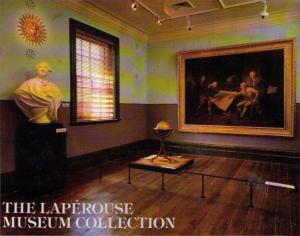 The Laperouse Museum Collection - Carole Roussel 1988 (pages 32-35, The Australian Antique Collector, June-December 1988)
The Laperouse Museum Collection - Carole Roussel 1988 (pages 32-35, The Australian Antique Collector, June-December 1988)
LAPEROUSE MUSEUM NOTES FROM THE OPENING
The Darling Harbour Maritime Museum was obviously keen to accommodate the Laperouse Association project in their building. Others wanted a French museum in Western Australia, where French explorers were more active, even though Laperouse never called there.
The Association, in turn, wanted the musem to be in the Cable House, on the spot where Laperouse landed, where they stayed for six weeks, and where the two monuments are.
It took a lot of goodwill from many N.S.W. Government Departments, mainly the National Parks and Wildlife Service and the N.S.W. Bicentennial Council, to organise the relocation of the Salvation Army and the financing-of the restoration to the building. The Department of Public Works did the job within the budget and, more importantly, within the very limited time-span left!!
* The complete budget of the project (excluding the incalculable N.P.W.S. participation) is: - $500,000 N.S.W. Bicentennial Council
$350,000 Laperouse Association fund- raising
$450, 000 French Government
$ l,300,000
The value of an historical and cultural centre is enormous. Efforts are now being made from all quarters to link La Perouse to Kurnell by ferry, so that together with Capt. Phillip’s landing site in Yarra Bay, the cradle of Australia becomes easily accessible, understandable and reputable.
* Such is the importance of the project that the Prime Minister, Mr Hawke sent his personal adviser on the Bicentenary, Ms Kathleen Taperell to view the site and the works in progress.
The importance of the museum was also recognised by the Mitchell Library, allowing the fine reproduction of the famous painting by Monsiau of Louis XVI giving his instructions to Laperouse to be moved on loan to the museum. Transporting and installing the painting was no easy task, it is almost 2m.x 3m.
* The museum will open to the public on 24th. February. Already many people are thinking of improvements. Most importantly attention is being given to an excavation project which could reveal where the stockade erected by Laperouse around his camp was, as well as where they planted the vegetable garden, later known as the Frenchmen’s Garden. One would now expect the suburb of La Perouse, so often forgotten, to become one of Sydney’s major historical and touristic attractions.
* Obviously the opening of the museum could not be planned for the 26th. January, the exact date of Laperouse’s arrival in Botany Bay. However the 23rd. February, being Laperouse Day, is also an appropriate choice. This date, set by the N.S.W. Government some years ago, falls within the six weeks spent by Laperouse.s expedition in Botany Bay. It is the day on which French and Australian officials and friends hold an annual commemorative ceremony around the monument erected to the memory of Laperouse in 1825 by the French navigator, Bougainville. A short prayer is also said beside the tomb of Father Receveur, a chaplain and botanist to the expedition, who died while they were camped there.
PEOPLE BEHIND THE SCENE
For the museum to “live”, change and evolve, it is important to have a group of interested people keen to help, participate and promote it. The Friends of the Museum now under the presidency of the Hon. W.J. Holt Q.C., aim to create exchanges of exhibits, visiting exhibitions, add to the museum’s own exhibits, arrange loans etc.. Backing the Friends is the-now famous Club 200. The Club was started so that financial participation
in the museum should not be left only to big corporations, but should also be within reach of individuals who wanted to be involved in the project. Hence the Club 200, making it possible for personal participators - their names appear on a roll of honour in the Vanikoro room. Little known to many are the secretaries of the Laperouse Association. There have been two secretaries sent from France. The first one, Stephane Duproz, was given a job which all young Frenchman would like to do instead of their military service. He was a VSNA (Volontaire Service National Actif). Some 2000 of them are sent overseas each year to work in consulates, companies or Associations such as the Laperouse Association.With a mind-opening experience, instead of peeling potatoes or dismantling guns!.!
The second, also a VSNA, was soon replaced by a charming young French graduated student, Claire-Me.splede, in Australia on a working holiday. With the Laperouse Association, she has certainly had more work than holiday.
Some of the well-known people that are coming for the opening of the museum are descendants of the Laperouse family, (Laperouse did not have any children), including Marc de Laperouse, a great,great nephew, and Serge Receveur, a decendant of Father Receveur’s Family.

You must be logged in to post a comment.